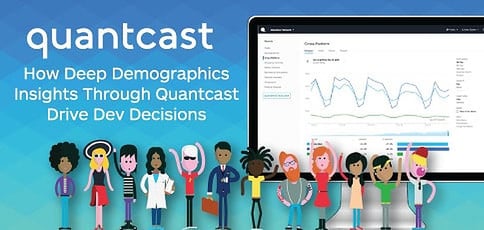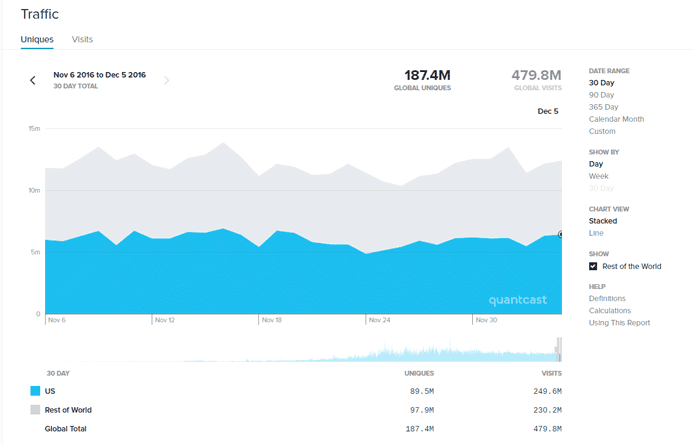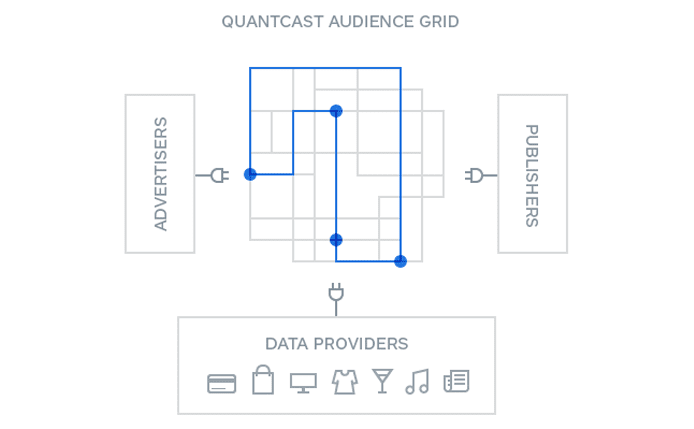
TL; DR: Website analytics only tell you what browsers do on your website. They don’t tell you about the people who visit your website. Analytics tell you what device they use and from what country. Quantcast products Measure and Audience Grid tell you who your visitors are, what they buy, what television shows they watch, and what they do online outside of your website. Smart business owners can turn that who-they-are and what-they-do data into what-they-want and what-will-sell-them information. That’s exactly what BuzzFeed did to become one of the US’s top 10 websites.
In the Western world, it’s nearly impossible for the average Internet user to have never visited, or at least heard of, BuzzFeed.com. A few years ago, that wasn’t the case. BuzzFeed was just another obscure publisher of read-quick, forget-quicker celebrity posts, quirky quizzes, and #fail-tagged photos. Thanks, in part, to their use of Quantcast, BuzzFeed is one of the top 10 websites in the US.
BuzzFeed’s goal was to publish and monetize content people wanted to read and share. The problem was BuzzFeed didn’t know enough about their audience. Standard website analytics — number of visitors, what browsers they used, what countries they were in — provided very little genuine audience insight and actionable intelligence.
Quantcast Measure gathers data from numerous sources not limited to websites. It collects, collates, and connects web usage behavior, to be sure, but it also culls demographic and behavioral details from hundreds of other sources that aren’t websites. Quantcast Measure, using Audience Grid, also collects deep demographic data on shopping habits, television viewing, automobile purchases and usage, political affiliations, and just about any other recordable information about the activities of connected humans.
This comprehensive set of data, once aggregated and cross-referenced, quantifies people’s activities and interests. This valuable information gives a publisher, like BuzzFeed, a deep understanding of their readers’ interests. More importantly, that understanding can be extrapolated to predict people’s behaviors and future activities.
The Quantcast audience data can be segmented into groups and labels that help define and identify different groups of visitors and would-be customers, and these breakdowns present tremendous value to site owners using Quantcast Measure.
Quantcast Measure Lets Site Owners Understand Their Visitors
Quantcast Measure provides detailed visitor demographics, including their interests, purchasing behaviors, and occupations. With it, site owners and developers can truly understand their visitors.
Smart companies realize the value of data and collect information from visitors to their websites, but they might not be using technology that unlocks all of the available details.
Some user information is automatically available without visitor interaction. The user’s browser and screen resolution, for instance, are transmitted to websites and recorded by a basic analytics system to provide insights into where and how visitors access the site — from desktop or mobile devices and even which mobile devices.
Then, there’s basic visitor response information that can be obtained. Given an incentive, many visitors will furnish details such as email address, physical address, age, education level, income, and other foundational demographics.
Most of the data they provide will be correct and not intentionally false, but separating truth from falsehood can be difficult. Depending on the types of visitors targeted, the true-to-false ratio is difficult to predict, thus skewing the results an indeterminate amount. And, of course, barring exceptional incentives, those who provide any information — accurate or erroneous — are always a minority of actual visitors. However, something is better than nothing.
Unfortunately, that’s the attitude adopted by some site owners. They seek data to better understand visitors, but they may not realize better technology is available. For these companies, the window into their audiences might as well be opaque.

Quantcast Measure allows site owners to quickly gather deep insights about their visitors.
Quantcast Measure draws back the blackout curtains and gives you a glimpse of your audience’s lives. Going far beyond revealing income and education level, Quantcast Measure presents deep demographics such as gender, ethnicity, and political affiliations. By collecting data and monitoring from thousands of sources, demographics are given meaning with details on audience interests and purchasing behavior.
Profiling people’s online activities beyond nebulous “spent X minutes on Facebook” analytics, Quantcast Measure identifies, categorizes, and makes available the number of times audience members engage in social media. Details emerge on Pinterest activities, taxonomies for Instagram content, and what times of day users post on Twitter, Facebook, and other platforms.
Content publishers, like CNN, The Onion, BuzzFeed, of course, and many others, can use Quantcast Measure to completely understand and profile their visitors based on user activity outside the publisher’s own sites. That data is golden, forming hard numbers and audience profiles the sales team can use to lure advertisers.
Quantcast Measure aggregates visitor data from thousands of sites and systems, seeing the average US online user more than 600 times per month. Everything that average user does online is recorded, categorized, and aggregated to provide massive benefits for all of Quantcast’s publisher clients.
Quantcast Audience Grid Provides Free & Fresh Consumer Behavior Data
Audience Grid is the data set that drives Quantcast Measure, and it’s available free of charge. Publishers and advertisers can connect to Audience Grid and integrate it into their own systems. That means everything Quantcast collects about online users — wherever they go, whatever they do — is available to any developer working on an application.
Lifestyle details, shopping history, television viewing habits, and more can be filtered, cross-referenced with other data points, and pulled in real time to target the bullseye of a market even as that bullseye changes position from minute to minute.
A game developer, for example, may use Audience Grid to understand the best market segments for initial sales, but also perform per-user, in-app customizations to reveal further sales opportunities. Audience Grid pulls TiVo Research™ data to identify the TV shows people watch. That data set can be filtered to include only users who watch Game of Thrones, Versailles, and Vikings — viewers of which are most likely to be interested in the new period game from the developer.

Quantcast Audience Grid is a deep data set that organizes info and makes it available to advertisers and publishers.
The qualifying-viewer set can now be further refined by wealth indicators such as income, car models owned, how often new cars are purchased, and investment data. Language, ethnicity, gender, and other factors can further divide the audience and inform the creation and refinement of sales tiers and campaigns.
If the game developer is careful in using the facts available from Audience Grid, no money should be wasted delivering sales messages to audiences who respond to different types of marketing.
Publishers Thrive with Quantcast Data Powering Their Efforts
BuzzFeed skyrocketed to popularity partially because Quantcast Measure gave the publisher the audience insight they couldn’t get from website analytics. With all that data collected by Quantcast from publishers, social media, and virtually every other kind of publishing, broadcasting, and retail entity, BuzzFeed was able to get inside the heads of their visitors and potential visitors.
BuzzFeed learned about people far beyond what they did on BuzzFeed.com, and they used that information to provide what people wanted and what would get them clicking, sharing, and talking.
With the site’s data-driven rise to the top 10 websites in the United States, BuzzFeed turned Quantcast information into a revenue-maker. BuzzFeed used their deep reader insight to create a valuable platform of sponsored content that lets advertisers hone in on their ideal demographics without blindly throwing darts at the wall, hoping to hit the occasional desired prospect.
Tami Dalley, BuzzFeed’s Senior Director of Research, put it best: “We use Quantcast to measure audiences for individual posts on BuzzFeed. Getting audience insight at the post level helps us demonstrate to advertisers how sponsored content can deliver their specific target audiences.”
And BuzzFeed isn’t the only publisher to have benefited from Quantcast’s massive and meticulously categorized data set. Sprint, AccuWeather, American Express, the Walt Disney Company, NBC Universal, and plenty of others among the who’s who of content and app publishers also peer into and learn about their audiences and customers through Quantcast Measure and Audience Grid.
HostingAdvice.com is a free online resource that offers valuable content and comparison services to users. To keep this resource 100% free, we receive compensation from many of the offers listed on the site. Along with key review factors, this compensation may impact how and where products appear across the site (including, for example, the order in which they appear). HostingAdvice.com does not include the entire universe of available offers. Editorial opinions expressed on the site are strictly our own and are not provided, endorsed, or approved by advertisers.
Our site is committed to publishing independent, accurate content guided by strict editorial guidelines. Before articles and reviews are published on our site, they undergo a thorough review process performed by a team of independent editors and subject-matter experts to ensure the content’s accuracy, timeliness, and impartiality. Our editorial team is separate and independent of our site’s advertisers, and the opinions they express on our site are their own. To read more about our team members and their editorial backgrounds, please visit our site’s About page.

